A few fish inspire greater devotion than koi. These large ornamental carp have now established a dedicated following in the West, matching that which they enjoy in their Japanese homeland.
Most Koi types were developed primarily for the beauty of their colors and patterning when viewed from above. This led to great interest in breeding and showing koi varieties, and the most desirable individuals now change hands for huge sums of money. To appreciate these attractive pond fish fully, they must be clearly visible through the water; as a result, koi are most often kept in well-filtered water in a pond containing few or no plants.
Understanding Koi Nomenclature
Distinguishing between koi varieties can be extremely confusing at first, partly because they are referred to in the West by traditional Japanese descriptions, even if they have been bred in other countries. Knowledge of a few basic terms, such as the words to describe the various colors and the main varieties (below), is a useful introduction to the complex world of koi nomenclature.
Koi Colors
Each Koi’s colors and patterns are different, just as the tastes of each keeper are different. The advice below will help you to choose the Koi you prefer. The permutation of pattern and color is almost limitless, so remember, if you see a good, healthy Koi that appeals to you, it does not have to look exactly like the photographs in this book. If you look hard enough, you will always find what you are looking for.
The intensity of the colour of your Koi will vary with changes in the light throughout the day. More noticeably, their colors will be at their best during the autumn. A varied diet throughout the year of pellet foods containing small amounts of carotene and spirulina, combined with natural foods, will help to maintain the colors of your Koi to their best advantage.
Exhibition-class Koi can be ordered from your local dealer, who will obtain photographs from which you can make your choice. The features to look for in fish to be exhibited are as described. For more details, visit a local Koi show and join one of the associations or clubs.
The standards and rules for judging are very similar throughout the various Koi clubs and associations. In general, although the patterns on some Koi can be the main attraction or even make a fish a show stopper at first glance, the judges will also consider the Koi’s figure, color, elegance, quality or imposing appearance.
Breeders in Japan work hard on improving the different colors and varieties of Koi. This progress, together with new colors and patterns that arrive as the parentage of Koi changes over the years, is one of the principal factors that make Koi an interesting and rewarding hobby.
Japanese descriptions of color are important in koi nomenclature. Some have multiple names depending on the form in which that color appears.
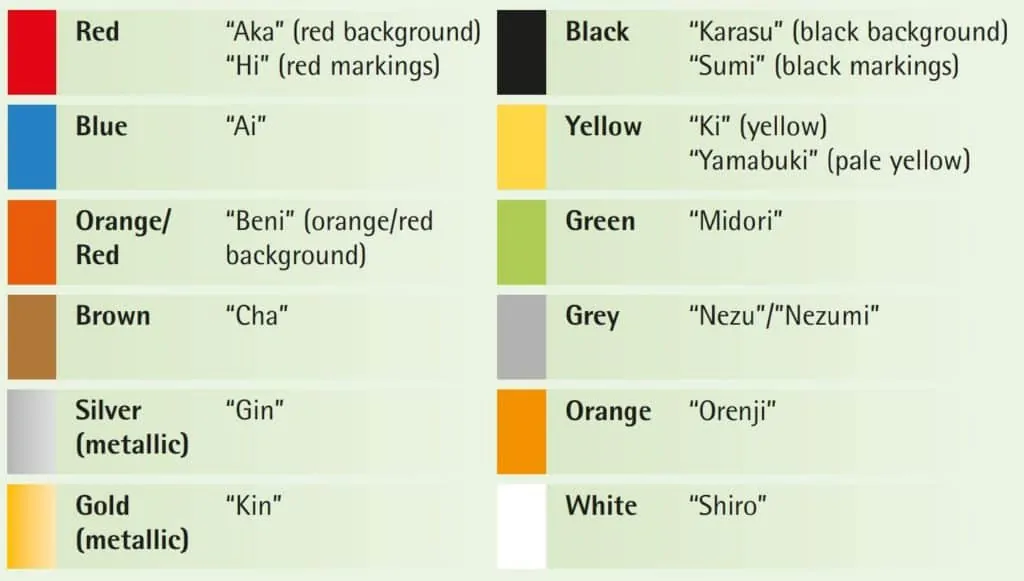
Koi Varieties
All varieties of Nishikigoi or Koi, have been produced to be viewed from above and are all from the same species of carp, with the exception of the Doitsu (scaleless type), which are the results of interbreeding leather carp and mirror carp.
| ORIGINS | Developed in Japan from carp brought from China. |
| SIZE | Slight varietal differences; typically up to 36 in (90 cm). |
| DIET | Specialized commercial koi foods of various types. |
| WATER | Temperature 37–77°F (3–25°C) and neutral (pH 7.0). |
| TEMPERAMENT | Relatively social but do not shoal. |
The illustrations below give examples of the main koi varieties, highlighting their individual characteristics. The most popular varieties, known collectively as “Go Sanke,” are the Showa, Kohaku, and Sanke. Varieties prefixed with the term “Hikari” are metallic koi, which have an overall reflective luster, while all others are known as nonmetallic. In addition to the color differences described here, the appearance of a koi is influenced by its pattern of scalation. “Doitsu” koi, for example, may have large mirror scales on either side of the dorsal fin, but are scaleless elsewhere, while the scale type known as “Kin Gin Rin,” or simply “Gin Rin,” is characterized by the sparkling appearance of the scales.
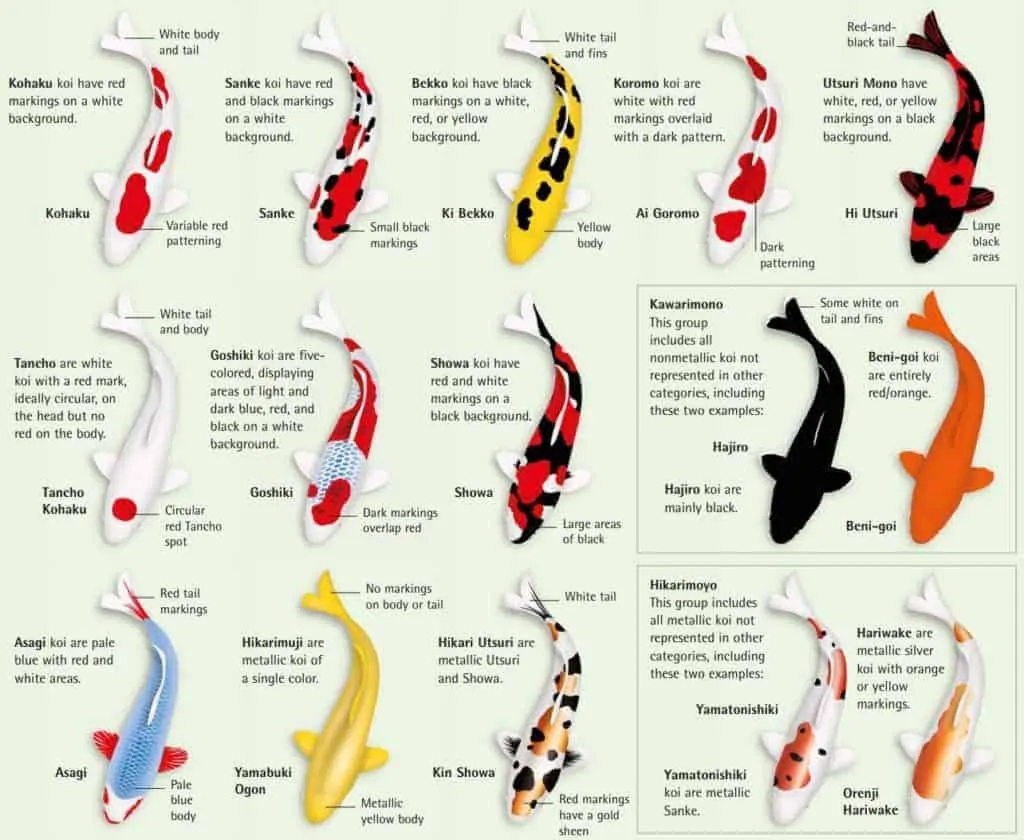
Kohaku
The white texture of the Kohaku’s body, tail and fins should be as pure as possible. The red markings, known as hi (hee), must be intense and distributed evenly along the body and above the lateral line, creating a well-balanced design.
Large hi patterns are more impressive and should start on the head and be distributed evenly to the tail, leaving the end of the tail joint. The head pattern must reach almost to the mouth, but must not cover completely the eyes or gill covers.
Although sometimes, as with other varieties, an unusual marking can impart great charm or beauty, a pattern that does not descend below.
The earliest forerunners of modern koi displayed simple red-and-white markings. Known as Kohaku, these koi rank today as one of the most popular varieties. Kohaku are characterized by their white body color and red (or “hi”) patterning. In the highest-quality Kohaku, it is particularly important that the white areas show no trace of yellowing (a fault known as “shimis”), while the red areas should be dense.
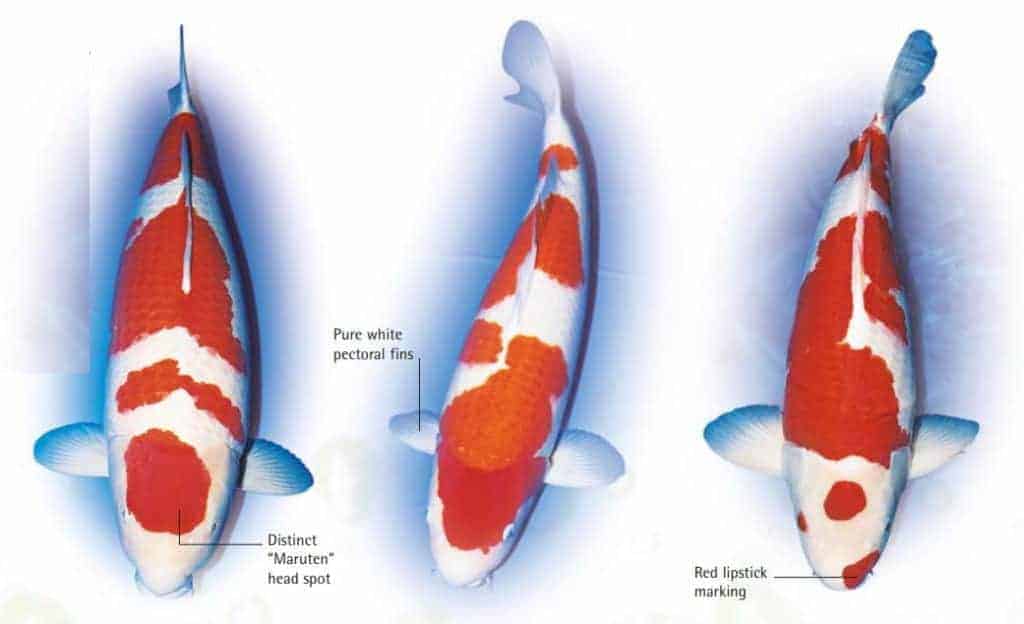
The border, or “kiwa,” at the back of each red patch must be well defined; at the front, however, the white scales overlay the red so the definition is not as sharp. Assessing the potential of young Kohaku can be difficult because their scales have a translucent nature a feature described as “kokesuke.” All Kohaku stem from six basic breeding lines, which are named after the Japanese breeders who developed them.
Taisho Sanke (Taisho Sanshoku)
One of the most popular koi varieties, Sanke probably first arose in the late 1800s, but only came to prominence in the early 20th century. These tri-colored koi display variable black or “sumi” markings superimposed on red-and-white coloration similar to that of Kohaku. The skin color of high-quality Sanke should be snow white, while large areas of red (“hi”) free from “sumi” are not considered desirable.
The Sanke is a white Koi with red and black patterns on the body. Elegance can be found through a large hi pattern, similar to that of the Kohaku, with a smaller black pattern, known as sumi (sue-mee), in between. A few sumi stripes on the tail or fins can enhance the overall beauty.
The sumi pattern can also be on, or mixed with, that of the hi, but this can give the overall design a heavy appearance, especially if it appears on the head. Each pattern should be distributed as evenly as possible above the lateral line and that of the sumi should reach only as far as the shoulders.
API STRESS COAT Aquarium Water Conditioner 16-Ounce Bottle
29% OffAPI STRESS ZYME Freshwater and Saltwater Aquarium Cleaning Solution 1-Ounce Bottle
$4.48 (as of June 11, 2025 01:09 GMT +03:00 - More infoProduct prices and availability are accurate as of the date/time indicated and are subject to change. Any price and availability information displayed on [relevant Amazon Site(s), as applicable] at the time of purchase will apply to the purchase of this product.)API ACCU-CLEAR Freshwater Aquarium Water Clarifier 4-Ounce Bottle
12% OffBear in mind, when buying a baby Sanke, that one with very few sumi markings but a large hi pattern will possibly become more elegant as it grows.
Large sumi patterns on a baby Koi will possibly break up with age, whereas hi patterns usually remain stable. Sometimes, however, a small hi pattern may appear to shrink in proportion with the body of the Koi as it grows.
A white Koi with a red crown on its head and a sumi pattern on the body is called a Tancho Sanke.
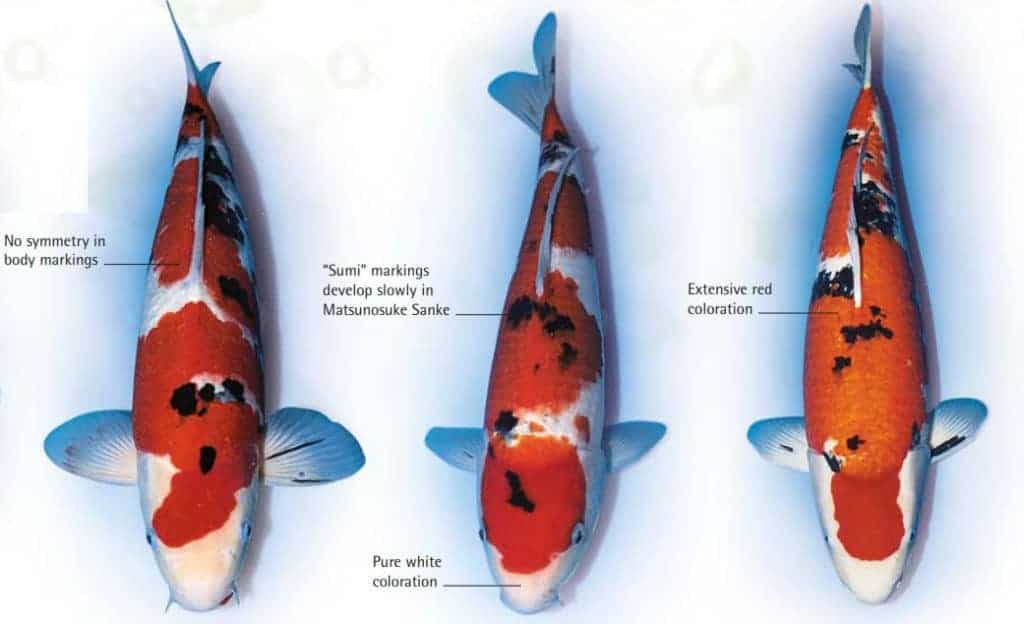
In addition, black patches should not be present on the head. Although asymmetry of patterning is not required, the overall effect should be balanced; the “sumi” markings, for example, should be evenly distributed and not simply restricted to one side of the body. It can be difficult to assess the exhibition potential of Sanke until they are at least two years old. Before this, some individuals may resemble Kohaku, while the “sumi” patterning in others, although evident, may not be stable and may even vanish for a period.
Hikarimoyo
The Hikarimoyo grouping encompasses all metallic koi of more than one color that are not categorized as Hikari Utsuri. This includes metallic forms of Kohaku and Sanke, and the popular Hariwake, which are metallic silver koi with orange (“orenji”) or yellow (“yamabuki”) markings. The metallic appearance of these attractive koi, which first came to prominence in the 1960s, means they are highly visible in the water.
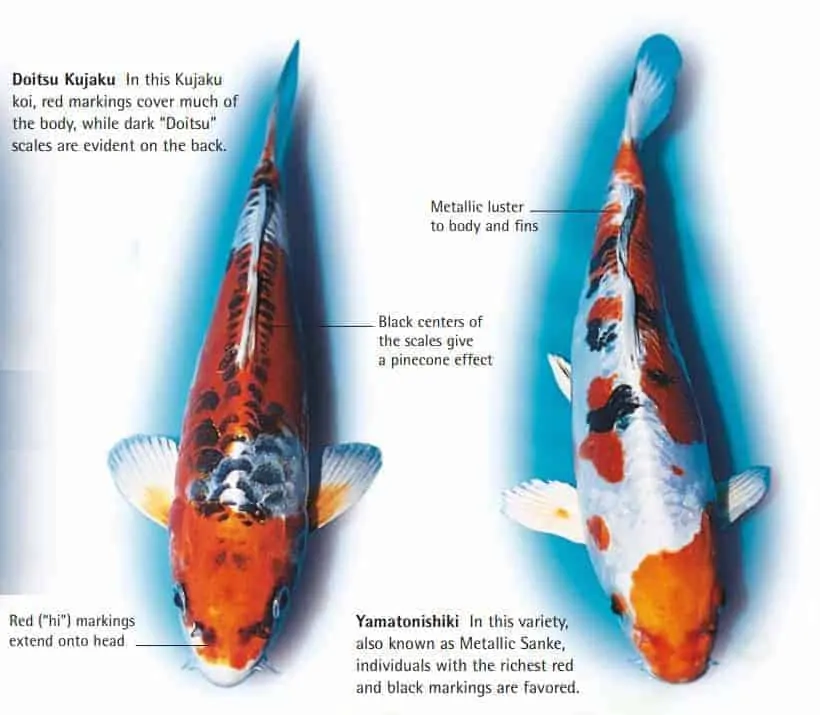
The reflective scalation, however, dilutes the depth of their base coloration, so that red areas tend to appear more orange, and black coloration appears grayish.
Goshiki
The name Goshiki literally means “five-colored,” referring to the white, red, light blue, dark blue, and black coloration of these koi. There may even be a sixth color evident, when a blue area is overlaid by black, creating a purple shade.
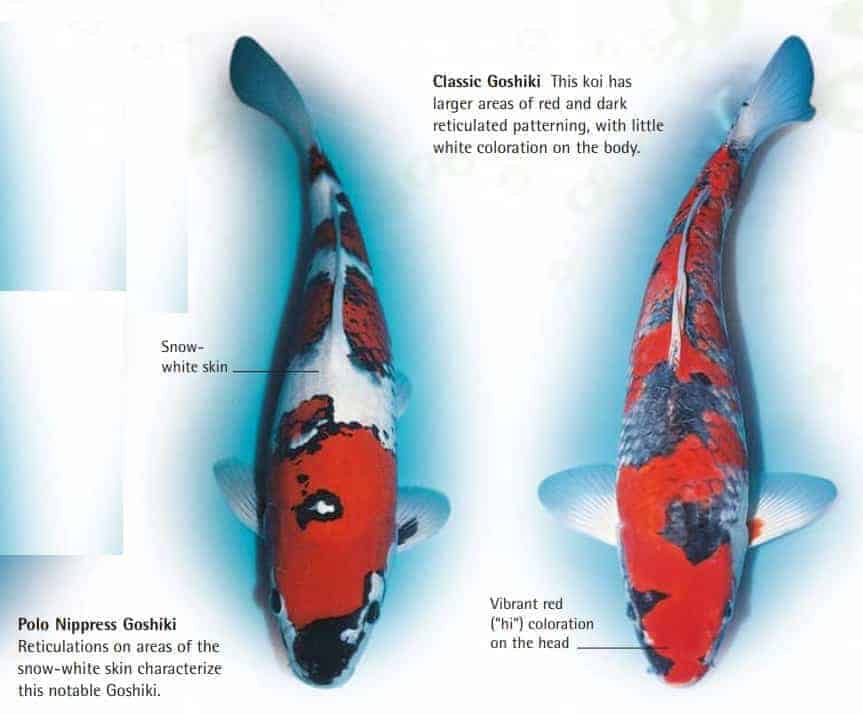
There is considerable variability between the koi of this group. The traditional form is relatively dark in color, but over recent years, some strains have been developed on much more colorful lines. Goshiki are now generally classified with Koromo, but were traditionally included in the Kawarimono category.
Hikari Utsuri
This category features metallic koi with Showa and Utsuri patterning. Hikari Utsuri are often strikingly colored but typically display little refinement in their patterning. Their metallic sheen can negate their depth of coloration; black (or “sumi”) markings, for example, are not as vivid in Hikari Utsuri as in their nonmetallic counterparts. This variety was developed when Ogons, which are single-colored metallic koi, were bred with Showa and Utsurimono stock.
Hikarimuji
Members of this group are single-colored metallic koi. They are all descendants of a single wild, black carp (or Magoi) with a golden stripe along its back that was discovered in Yamakoshi prefecture in 1921. A selective breeding program from this fish, carried out by the Aoki family, produced the first pure colored metallic koi (or Ogon) 25 years later.
Hikarimuji have become immensely popular with koi enthusiasts because they show well in ponds, are easily tamed, and grow fast.
Showa Sanshoku
One of the most popular koi varieties, Showa were originally developed during the late 1920s. It was not until the 1960s, however, following crosses with Sanke and Kohaku varieties, that the yellowish markings of these early Showa were transformed into the vibrant red that is a feature of the variety today.
The Showa Sanshoku is a black Koi with red and white patterns and was bred a few years after the Sanke. The Showa is very similar, being red, white and black, but is distinguished by having sumi and hi as the dominant color.
Again for elegance, as with the Kohaku, a large hi pattern is preferred, but this time with a large sumi pattern that may descend below the lateral line and also appear on the head. The fins and tail should be white, but the pectoral fins must have sumi at the joints. There is sometimes a noticeable difference in the texture of the sumi, and on some Showas it will assume a purple hue.
A Showa with more white, or an equal amount of white, is called a Kindai Showa, and where hi is the dominant feature from the head to the tail, it is known as a Hi Showa. A Showa lacking a hi pattern, but with a red crown on its head, is known as a Tancho Showa.
Showa can be confused with Sanke koi, which also have red, black, and white coloration. They can be distinguished by the extent and distribution of black (“sumi”) markings on the head and body. “Sumi” patterning is more dominant in Showa than in Sanke, and the black markings extend on to the head and below the lateral line.
In contrast, Sanke only have “sumi” on the body and above the lateral line. The patterning of Showa koi can change considerably as they mature, which makes it extremely difficult to assess the potential of young koi of this variety.
Kawarimono
This diverse grouping encompasses all nonmetallic koi (“Kawari”) that are not included in other categories, although most are named and recognized varieties in their own right. Among the most popular are single-colored koi of various colors, which can provide a striking contrast to patterned koi in a pond.
This category also includes koi that are predominantly black in color; these are considered to be the koi most closely related to the ancestral Magoi. In addition to koi with standard matt coloration, Kawarimono includes partially scaled (“Doitsu”) and shiny-scaled (“Gin Rin”) varieties. Rarities unique koi that do not fit into other groups and whose parentage may be unknown also feature in this group. There is some variation between the koi considered to be Kawarimono in Japan and the standards elsewhere in the world.
The Origins Of Koi
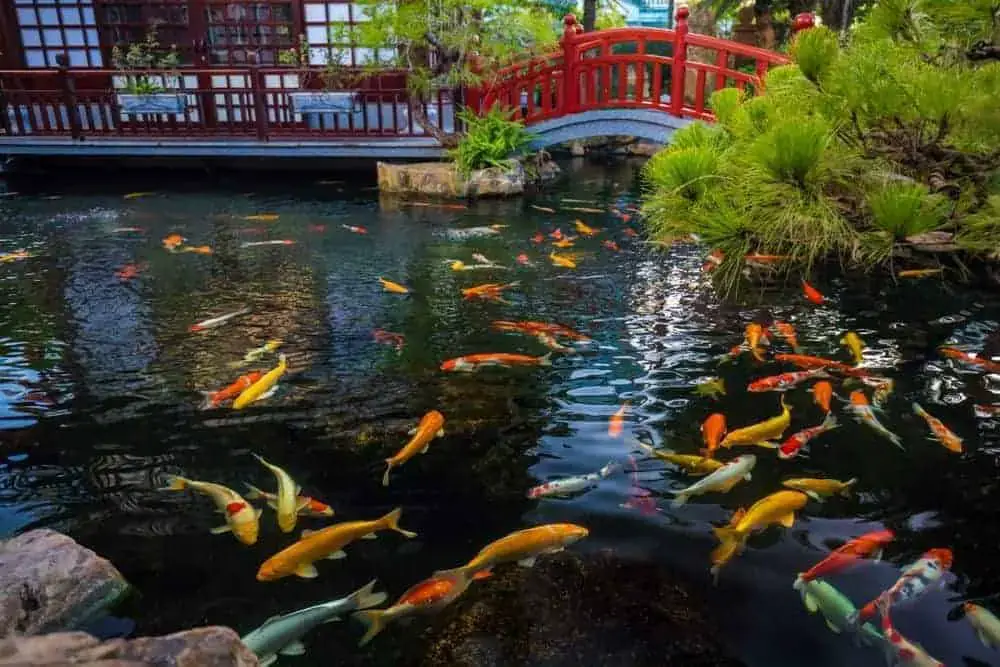
Today’s modern koi varieties are descendants of black carp, known as Magoi, which were introduced to Japan from China around 1000 AD. By the 1600s, these plain-looking fish were thriving in the waterways around the paddy fields of Niigata prefecture on Honshu Island, and the local rice farmers caught them for food.
Around the early 1800s, individual fish displaying patches of color and patterning on their bodies started to appear, and some of the farmers began to selectively breed for these characteristics. Known as “Nishikigoi,” or “brocaded carp,” these colorful fish attained public recognition when a group was shown at the 1914 Taisho Exhibition in Tokyo, and a number were then transferred to the moat surrounding the Emperor’s Imperial Palace.
Their descendants can still be found there today. Koi-keeping and breeding subsequently became extremely popular in Japan, signaling the birth of the lucrative Japanese koi industry of today. Koi were first introduced to the US in the early 1940s. It took longer for them to gain recognition in Europe; koi were not seen in Great Britain until the 1960s.
Since then, they have gained a huge international following, and are now bred not only in Japan but in other countries, including the US, Israel, China, Korea, Thailand, and South Africa.
Growth And Development
Few pond fish live longer than koi; indeed, a number of the original eight koi transferred to the moat around Japan’s Imperial Palace following the Tokyo exhibition of 1914 were still sighted there over 50 years later.
Koi also rank among the largest of all pond fish, with some individuals reputedly reaching up to 6 ft (1.8 m) in length. Overall size is partly dependent on variety; Chagoi, for example, naturally grow to a much larger size than most other koi. An individual koi grows to almost half its potential adult size in the first two years of its life, and if kept in optimum conditions, has a growth rate in this time of 1 in (2.5 cm) per month.
This rate is largely influenced by the koi’s environment including the quality and temperature of the water and the stocking density in the pond and also by the amount and quality of food provided. After this stage, the rate of growth declines, and a koi will not reach its full adult size until it is 15 years old. The color and patterning of some varieties can change as they grow and develop. This is especially true of Matsukawabake koi, which have unstable black-and-white markings that can alter in response to changes in environmental conditions.
How long Koi fish grow to full size?
For an approximate guide, a Koi can grow to 10-20 cm (4-8 in) in length during the first year and 20-30cm (8-12in) in the second. Between the ages of two and three years, they will become adults and possibly grow a further 10cm (4in), but it could take another seven years to reach the average length of 70cm (28in).
Koi grow at different rates and it can be difficult, in some cases, to know their exact age. As with humans, their growth rate slows down as they reach adulthood.
The growth rate of your Koi will depend entirely on their environment, which is influenced by pond depth, stocking rates, filtration, water temperature, and feeding.
How long is the lifespan of koi fish?
Koi have a long life span compared with other ornamental fish and, depending on their environment, will live to 15-20 years or even more and reach a weight of 5-10kg (11-22lb). The above figures are only an approximate guide to age. The scales of a Koi will reveal its true age since they are marked by growth rings that can be seen if a scale is examined under a microscope.
What is the longest living koi fish?
The greatest recorded age attained by a Koi is more than 200 years.
Koi Feeding And Nutrition
Koi eat both plant and animal matter, instinctively seeking their food close to the bottom of the pond. The two pairs of barbels on either side of the mouth serve as sensory feelers, helping them to locate edible items, such as worms, hidden in the substrate.
Koi are also able to dig quite effectively using their jaws, a behavior that is likely to prove disruptive in a planted pond. The koi’s jaw structure is surprisingly flexible, which allows them to suck fairly large edible items directly into their mouths. At the back of the throat are toothlike structures that grind food before it is swallowed, making it more accessible to digestive enzymes.
Koi do not have a stomach, where food can be stored, and so can only digest small amounts of food at a time. Swallowed food passes directly into the intestinal tract, and nutrients are absorbed as the food passes through before exiting the body.
In adult koi, the intestine is two or three times the length of the body, while young koi have much shorter intestines, and so require a higher protein content in their food to achieve the same levels of nutrition.
Climate Issues
Winters can be harsh in places where koi originate, and today’s established koi varieties are hardy enough to spend the winter in an outdoor pond in all but the coldest climates. An outdoor koi pond must be sufficiently deep, however, to ensure that the fish will not become trapped in any ice that forms. Pond heaters can help to prevent the surface from freezing over.
As water temperatures drop, koi spend more time at the bottom of the pond and start to eat less. Young fish may be better housed in an aquarium over the winter, since spending time in this torpid state temporarily slows their rate of growth.
Hot weather also brings its hazards. Increasing water temperature can reduce the amount of oxygen in the pond to dangerously low levels. Evaporation increases and the pond is likely to require regular refilling with dechlorinated water. Fish should be checked more regularly for signs of disease in summer because infectious agents can multiply more quickly in warm weather. Screening may also be required in very hot weather, to provide shade over the pond and so help to prevent pale-colored fish from suffering sunburn. Canopies fashioned from bamboo matting on wooden supports are a popular decorative option for this purpose.
Koi And Japan
Most koi of Japanese origin command premium prices in the international marketplace, reflecting not only the individual quality of each koi but also the rigorous selection procedures that breeding stock must meet in their homeland.
Koi-breeding in Japan is still largely carried out by a number of well-known families who have koi breeding lines extending back over centuries; a chosen family name is now often included in the name of an individual koi to indicate that it has this ancestry. A Matsunosuke Sanke, for example, is developed from the famous Matsunosuke line, a breeding line that has come to prominence since the 1960s.
There are often subtle but recognizable differences between koi of the same variety but from different breeding lines, not just in the appearance of the adult fish, but also in the development of their markings.
Kichinai Sanke, for example, have a reputation for having very stable black (“sumi”) markings, while the “sumi” patterning on a Sanke with Matsunosuke ancestry is a pale bluish-gray shade at first, but subsequently darkens as the koi matures.

Hi, my name is Sean, and I’m the primary writer on the site. I’m blogging mostly about freshwater and saltwater aquariums, fish, invertebrates, and plants. I’m experienced in the fishkeeping hobby for many years. Over the years I have kept many tanks, and have recently begun getting more serious in wanting to become a professional aquarist. All my knowledge comes from experience and reading forums and a lot of informative sites. In pursuit of becoming a professional, I also want to inspire as many people as I can to pick up this hobby and keep the public interest growing.
Read more about Sean.
Please join also my Facebook group.




















